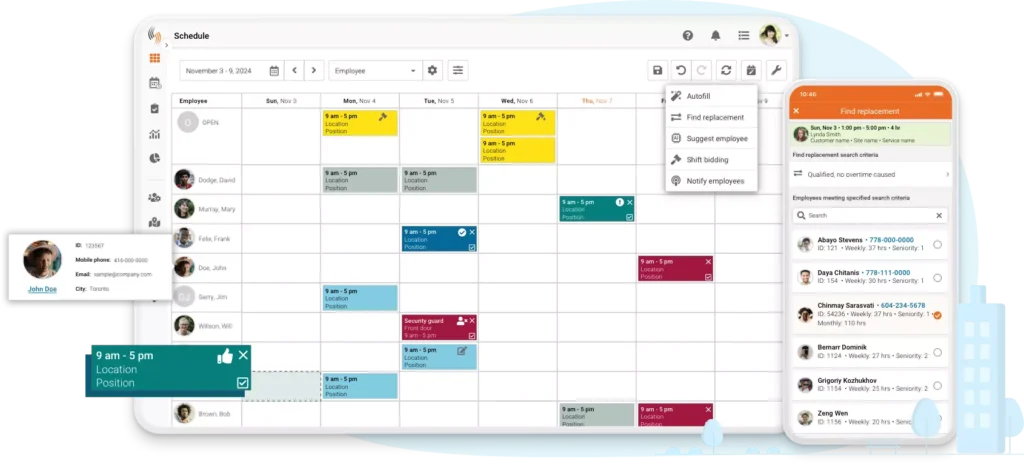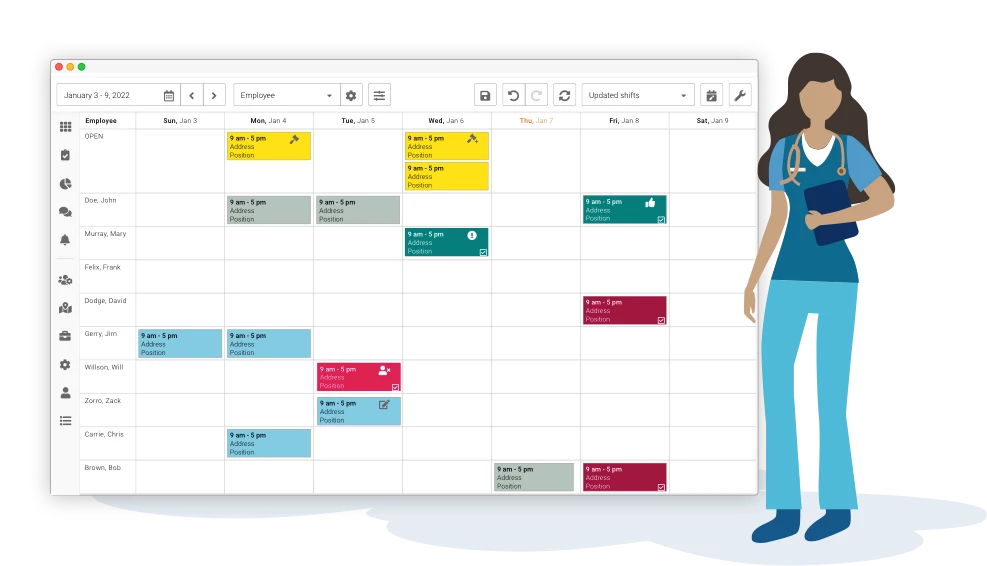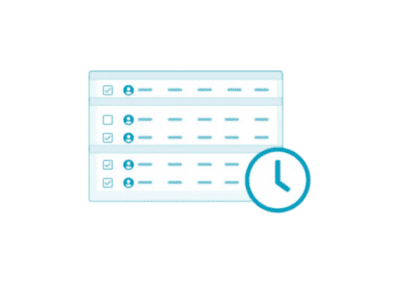Does your business rely on 24/7, round-the-clock coverage? Or maybe you operate long days that mean there are multiple shifts in each day? You might be using split shifts to fill your schedule, right?
Expecting employees to work long, continuous shifts can negatively affect their physical and mental health. You may have wondered how businesses can ensure round-the-clock service without burning out their employees. After all, it is not feasible or fair to expect employees to work around the clock.
Research has shown that long working hours can significantly negatively impact employees’ physical and mental health. So, how do businesses maintain optimum staffing levels to serve customers while considering their team’s well-being? The answer may be more straightforward than you think, and it’s something you might have yet to hear of: the split shifts.
What is a Split Shift?

A split shift is a shift pattern that divides an employee’s workday into two or more parts, with a substantial break in between. In this blog, we will delve into these shifts and their advantages for employees and managers. We will also explore how to implement them effectively. We will also explore the role of scheduling software in optimizing employee schedules that involve split shifts.
What Is a Split Shift Schedule?
For split shifts, employers divide an employee’s work hours into distinct blocks with a break of at least two hours in between shifts. Unlike a standard one-hour lunch break, common in a 9-to-5 schedule, it involves an extended break during which employees are not on duty.
Now, you might be thinking, “Don’t we already do that with lunch breaks?” Well, not quite. That standard hour lunch break in the middle of a shift doesn’t really count. It’s just a lunch break, not a break break.
Here’s an example to illustrate the concept: Imagine a restaurant that operates from 10 a.m. to 10 p.m. To handle the lunch and dinner rushes well, the manager schedules a server from 10 a.m. to 2 p.m. Then, the server works again from 6 p.m. to 10 p.m. In this scenario, although the employee’s workday spans 12 hours, they only work for eight hours, with a four-hour break in between.
Only managers can assign a split shift. Schedulers must highlight split shifts on the schedule clearly. In some places, employees must leave the workplace during their break between shifts. This is needed for a split shift to be valid.
Do Employees Still Work a Full Day?

Absolutely, split shift employees do still work a full day. A split shift doesn’t shorten the total work hours; instead, it rearranges them into distinct blocks. The total time worked in different shifts adds up to a regular workday. This can be eight hours, ten hours, or any other full-time equivalent.
The main difference is that these hours spread out, with a long break in between, rather than occurring all in one go.
In some states, labour laws require employers provide an extra wage; a split shift allowance, to workers who complete a split shift. This is because they can be less convenient for employees, impacting their personal time or incurring additional commuting costs.
Employers design split shift allowances to balance out these potential inconveniences. This makes these arrangements more attractive and fair to employees.
Calculating the Split Shifts Premium
In regions like California, employers must pay a premium to employees who work split shifts. This premium compensates employees for this scheduling arrangement’s inconvenience and additional expenses.
The formula for calculating this premium is as follows:
Total Pay at Minimum Wage + One Extra Hour at Minimum Wage – Total Pay at Regular Hourly Rate = Split Shift Pay/Premium
Let’s break this down step by step:

- To find the employee’s pay for the day, multiply the total hours worked by their hourly rate.
- Calculate the employee’s daily pay using the minimum wage rate. Use the local or state minimum wage, whichever is higher. Add an extra hour at the minimum wage rate.
- Compare the two amounts. If the pay for an extra hour at minimum wage exceeds the regular pay, the employer owes the employee a split shift premium. This premium is the difference between the two amounts. Let’s look at an example.
An employee in San Francisco works from 11 a.m. to 3 p.m. They also work from 6 p.m. to 10 p.m.
The local minimum wage is $16.99 per hour. Their regular hourly rate is $18 per hour. The employer would calculate the split shift premium like this:
Regular Pay: $18 x 8 hours = $144
Minimum Wage Pay: $16.99 x 8 hours + $16.99 (one extra hour) = $152.91
Premium: $152.91 – $144 = $8.91
Industries Where Split Shifts Are Prevalent
The prevalence of split shifts can vary significantly across industries. For example, about 37.5% of workers in the transportation and warehousing industry had shifts outside the usual daytime hours. In contrast, the leisure and hospitality industry had about 26.4% of its workforce working non-standard shifts, including split shifts.
Hospitality:
In the bustling world of hospitality, which includes hotels, restaurants, and bars, split shifts are a common scheduling strategy. This approach ensures that these establishments maintain an optimal level of staffing during peak meal periods and special events. In this industry, different roles like front desk staff, chefs, servers, and bartenders often work split shifts. They do this to cover breakfast, lunch, and dinner services.
Public Transportation:
Public transportation services, such as buses and trains, are vital in keeping communities connected around the clock. Many transportation personnel, including drivers, utilize split shifts to provide continuous coverage. Strategists designed these shifts to accommodate peak travel times, ensuring commuters have transportation options during the day and night.
Healthcare:

The healthcare sector operates 24/7 to meet the needs of patients. Healthcare facilities, including hospitals, rely on split shifts to ensure constant care. Medical professionals such as nurses, doctors, and support staff often work split shifts. This ensures patients receive the required attention at any hour.
Customer Support Centers:
In today’s globalized world, businesses offering customer support services cater to customers in various time zones. As a result, it’s common for customer support centers to employ split shifts. This scheduling approach guarantees that customers can access assistance and solutions whenever needed, regardless of location.
Retail:
Large retail establishments frequently utilize split shifts, especially during peak seasons like holidays. These shifts are instrumental in covering stores’ extended opening and closing hours. By doing so, retailers can efficiently manage their workforce to provide constant service to shoppers.
Benefits of Split Shifts
Advantages for Employees
Easy Child & Family Care:
The flexibility inherent in split shifts empowers employees to address family-related responsibilities seamlessly. Whether picking up children from school or tending to ailing family members, split shifts enable individuals to fulfill their familial obligations without compromising their full-time work hours. This harmonious balance fosters a healthier work-life balance, diminishing the stress of juggling family duties during working hours.
Statistics:
According to a U.S. Bureau of Labor Statistics survey, approximately 3% of American workers follow a split shift schedule. This work arrangement significantly benefits parents of small children, allowing them to cater to childcare needs effectively.
Increased Hours Without Affecting Existing Shifts:
Part-time employees seeking to expand their working hours find split shifts particularly advantageous. This scheduling approach allows them to augment their weekly hours without interfering with the established schedules of their full-time colleagues. This flexibility benefits both employees, who can boost their income, and employers, who can meet varying workload demands efficiently.
Statistics:
Research from the Economic Policy Institute reveals that approximately 9% of transportation, utilities, and agriculture workers adopt split shift schedules to optimize their working hours.
Advantages for Managers
Cost Control:
Effective management of labour costs is a paramount concern for businesses across industries. Split shifts serve as a potent tool in this regard. By strategically scheduling breaks during off-peak hours, organizations can maintain an appropriate workforce level to meet customer demand while mitigating superfluous labour expenses. This judicious allocation of labour resources aligns with fiscal responsibility and efficiency principles.
Statistics:
Split shifts are prevalent in sectors characterized by continuous operation, such as public transportation and healthcare. 37.5% of employees work shifts other than the regular daytime schedule in the transportation and warehousing industry. This highlights the sector’s reliance on non-standard shifts to control costs.
Improved Productivity:
Research studies have consistently shown an intriguing phenomenon—an inverse relationship between constant work hours and employee productivity. In simpler terms, employee productivity tends to decline as the duration of consecutive work hours increases. Split shifts solve this challenge by allowing employees to rest and recharge during their break periods.
This break between work sessions gives employees a chance to rest. This helps with heightened productivity and an enhanced ability to deliver exceptional customer service during their second work segment.
Statistics:

Research from the American Psychological Association (APA) highlights how split shifts help protect employee well-being and work performance. Irregular work hours, including split shifts, can influence work-life balance and overall quality of life. Businesses that recognize the significance of these scheduling practices are better positioned to maximize productivity while promoting employee welfare.
Is a Split Shift Right for Your Business?
While split shifts offer numerous benefits, they may not suit all types of businesses. Office environments typically have more consistent activity levels throughout the day. This is different from places like restaurants or call centers, which experience more fluctuations.
Industries like food service, call centers, public transportation, and hospitality often use split shifts. These industries have clear times of high and low demand.
Before using split shifts in your business, think about your industry, the availability of workers, and your employees’ preferences. Evaluating whether split shifts’ benefits align with your business goals and needs is essential.
Tips for Implementing Split Shifts
Know the Local and Federal Laws: Before introducing split shifts, familiarize yourself with federal, state, and local laws regarding split shifts. The Federal Fair Labor Standards Act and state-specific regulations may dictate employers’ scheduling and compensation of split shifts. Consulting with a labour lawyer well-versed in your area’s requirements can provide additional guidance.
Factor in Commute Time: Recognize that split shifts can increase employee commuting time and expenses. Consider how this affects their work experience and minimize the impact by providing adequate break times.
Keep Meticulous Records: Accurate record-keeping is crucial when implementing split shifts. Maintain records of start and stop times, meal breaks, and the specific requirements of each split shift in your employee handbook to ensure compliance with labour regulations.
Legal Considerations for Split Shifts in Specific States
It’s essential to know state-specific laws and regulations regarding split shifts, as they can vary significantly. Let’s take a closer look at split shift rules in a few specific states:

California
California law mandates employers to pay an additional hour’s wage at the state or local minimum wage rate (whichever is higher) to employees working split shifts. The calculation for the premium can be intricate, considering the regular hourly rate and minimum wage rate. This premium compensates employees for the inconvenience of split shifts.
District of Columbia
In Washington, D.C., employees working split shifts are entitled to an additional hour of pay at the minimum wage rate if their break between shifts is longer than one hour. Employees residing on-site may be exempt from this requirement.
Illinois
Illinois does not have specific laws regarding split shifts. The Chicago Fair Workweek Ordinance says employers must give employees a break of at least ten hours between shifts. This rule applies when they schedule workers to work again. This regulation aims to ensure that employees have sufficient time for rest and recovery between work periods.
New York
In New York, hourly workers in the service industry can earn one extra hour at minimum wage for a split shift. Additionally, if the start and end of an employee’s workday exceeds ten hours, they are eligible for the spread of hours pay, including an extra hour of pay at the minimum wage rate. Employers can offset this premium against any amount paid above the minimum wage.
Oregon
Oregon mandates that employees receive time and a half for any shift that starts less than ten hours after the end of their previous shift. This ensures that employees receive an adequate break between shifts and get compensated for shorter intervals between work periods.
The Role of Scheduling Software

Implementing split shifts can be complex, especially when managing multiple employees and schedules. This is where scheduling software like Celayix comes into play. Employee scheduling software streamlines the process of creating and managing split shift schedules. This makes it easier for managers to optimize staffing levels and ensure compliance with labour laws.
Celayix, with its advanced scheduling rules engine and artificial intelligence capabilities, provides businesses with the tools needed to implement split shifts efficiently. Here’s how scheduling software can assist:
Effortless Schedule Creation:
Scheduling software simplifies creating complex split shift schedules. Managers can input employee availability and preferences, and the software can generate optimized schedules that meet business needs while considering employee requirements.
Real-Time Insights:
Scheduling software offers real-time visibility into labour costs and scheduling conflicts. It provides warnings about double-booked employees and helps managers make informed decisions to maintain cost control.
Automated Time Tracking:
With time clock and payroll integration, scheduling software like Celayix tracks employee work hours accurately. This makes it easy to calculate split shift premiums and other extra pay when needed.
Conflict Resolution: Scheduling software can identify and resolve scheduling conflicts, ensuring employees receive adequate breaks between split shifts and comply with labour regulations.
Ensuring Compliance and Fair Scheduling
To ensure compliance with split shift regulations and create fair scheduling practices, employers need to maintain meticulous records, calculate compensation accurately, and keep employees informed about their rights and schedules.
Employee scheduling software like Celayix can streamline these processes. We help businesses maintain efficient, compliant, and employee-friendly split shift schedules.
In conclusion, split shifts provide a flexible scheduling option for businesses in many industries. This approach helps them offer services all day while keeping labor costs low. However, implementing and managing split shifts requires careful consideration of labour laws and employee preferences. Scheduling software like Celayix can streamline the process, ensuring compliance, efficiency, and employee satisfaction.
The use of split shifts differs by industry. However, it is still a useful tool for businesses. It helps them maintain coverage and staff during busy times. Companies should be aware of state-specific regulations, such as California’s split shift premium, to ensure fair compensation for employees working split shifts.
If you want to learn about the benefits of a split shift schedule for your company, contact us today. We can provide more information and help you with a consultation.





